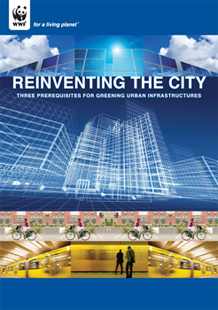Reinventing the City - Greening Urban Infrastructures
 Cities play a vital role
Cities play a vital rolein the quest to achieve global ecological sustainability. They are
the largest contributors to greenhouse gases and climate
change.
However, through sustainable construction and the better use of
urban infrastructure, cities could become a critical leverage point
in global efforts to drastically reduce emissions and avoid the
social and economic costs associated with climate change, as well
as enhance energy security and resilience in the face of high
fossil energy prices.
This is the key message in a new report by the World Wildlife
Fund. It notes, the world’s urban centers already account for close
to 80 percent of CO2 emissions. In the next three decades, the
global population will continue to grow and become ever more
urban.
Booz & Company analysis conducted for this report shows that
under business-as-usual (BAU) assumptions, $350 trillion will be
spent on urban infrastructure and usage during this period. This
huge expenditure either can cause the ecological impact of our
cities to become even more pronounced or can be a tremendous
opportunity to reduce that impact.
To meet the urban challenge, cities around the world-in
developed and developing nations-need to tackle climate change
directly. Cities in developed nations can apply new technologies to
mitigate greenhouse gas emissions stemming from the usage of their
existing infrastructure, says the report.
They can invest in mobility management and incentivize
sustainable lifestyle choices.
Cities in developing nations can adopt best practices in urban
planning and mobility management, as well as technological
advances, to design sustainability into their new
infrastructure.
Says the report, cities could become either a force for
environmental destruction or a primary source of ecological
rejuvenation.

To achieve the latter result, the US$350 trillion to be spent on
urban infrastructure and usage over the next 30 years will have to
be directed towards low to zero carbon emissions, partic-ularly in
the world’s small but fastest-growing cities and developing
nations, where the largest impacts can be made.
There are three prerequisites for this effort:
• Cities must adopt aggressive
energy reduction goals and best-practice approaches to urban
planning.
• Innovative financing strategies are needed to provide $20
trillion to $30 trillion in funding for additional up-front capital
costs, with developed nations working together to assist developing
nations in their low-carbonurban infrastructure initiatives.
• The latest technological advances must be utilized to support and
enable the planning, construction, and usage of urban
infrastructure in all cities.
The report argues if the will can be mustered to aggressively
pursue urban sustainability, and these three prerequisites can be
put into place, forward-thinking and aspiring urban leaders can
generate urgently needed reductions in global emissions, produce
attractive economic returns by transforming their cities into
centres for ecological innovation, and enhance their energy
security.
Download:
target=”_blank”>Reinventing the City: Three Prerequisites for
Greening Urban Infrastructures (PDF, 947.36
K)
Source: www.policyinnovations.org

